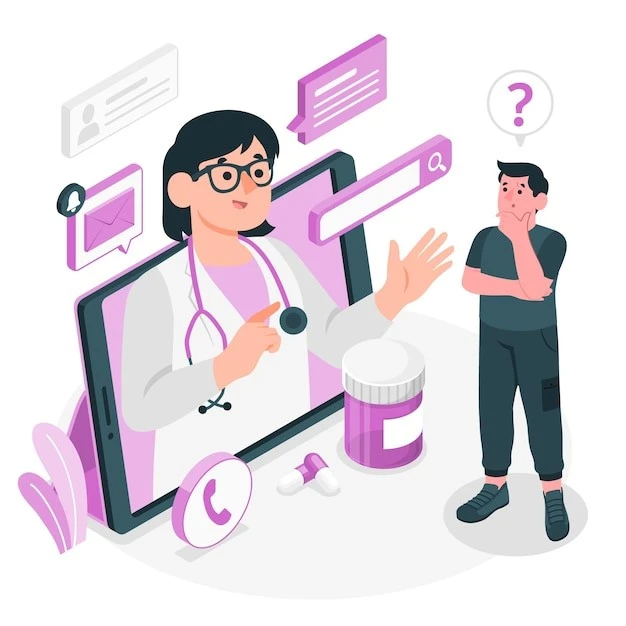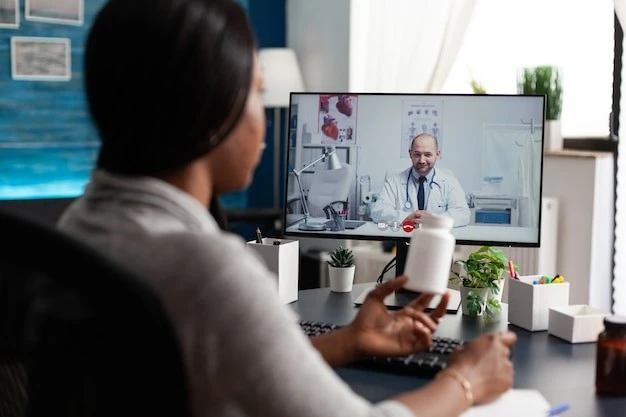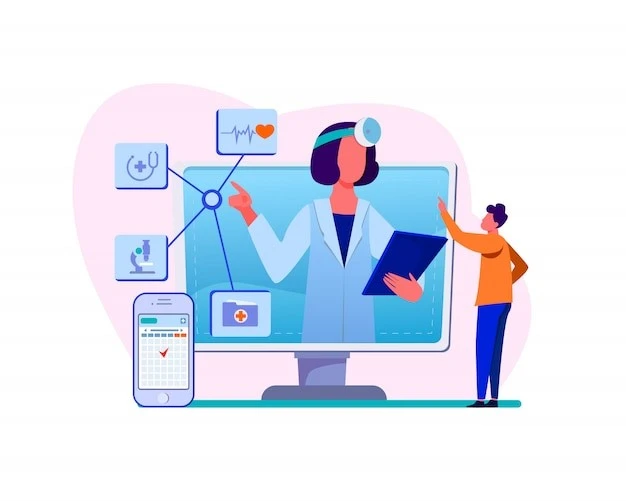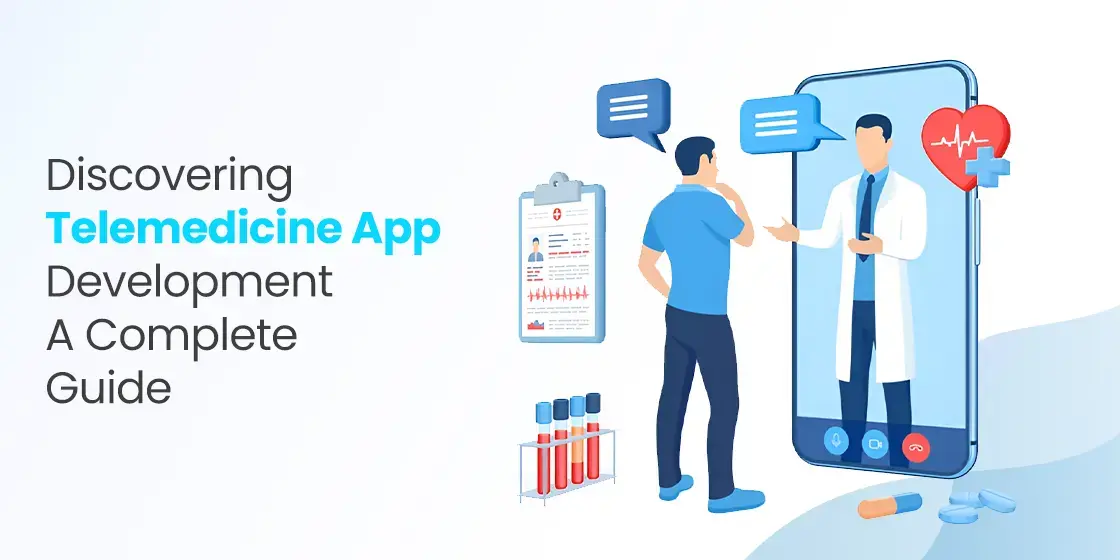Table of Content
Discover How a Telemedicine App Development Process Makes the Process Easier
Telemedicine, the delivery of healthcare services remotely using telecommunications technology, has emerged as a possible solution to address the evolving healthcare needs of today. At the forefront of this revolution is the development of sophisticated telemedicine applications, which connect patients and healthcare providers in virtual environments, enabling consultations, diagnoses, monitoring, and even treatment from the comfort of their homes.
The telemedicine app development process, however, requires a careful and multifaceted approach. It demands not only technical expertise but also a deep understanding of healthcare workflows, regulatory compliance, and the unique needs of both patients and medical professionals.
In this guide, we aim to navigate the intricate process of telemedicine application development from the lens of mobile app development services, providing a roadmap to create impactful solutions. By understanding these essential steps, developers can effectively contribute to building telemedicine applications that are not only technologically sound but also ethically responsible and truly transformative for healthcare delivery.
Let’s begin.
What is Telemedicine?

Telemedicine, at its core, refers to the use of electronic information and telecommunication technologies to provide healthcare services and information remotely. This encompasses a wide range of applications, from virtual consultations and remote patient monitoring to electronic prescriptions and the transmission of medical images.
The primary goal of telemedicine is to improve patient access to healthcare, enhance the efficiency of healthcare delivery, and ultimately improve patient outcomes, particularly in situations where geographical distance, time constraints, or physical limitations might otherwise become barriers to receiving timely and appropriate medical care.
Common forms of telemedicine include:
- Live video conferencing between patients and doctors (synchronous telemedicine)
- The secure transmission of medical information such as images and lab results for later review by a healthcare provider (asynchronous telemedicine or store-and-forward)
- Remote patient monitoring (rpm) using devices to track vital signs and health data
- Mobile health (mhealth) applications that provide health information, appointment reminders, and facilitate communication.
Medical device software development as a whole can bridge the gap between patients and specialists who may be located far away. It can do so by providing convenient follow-up care, and empower patients to actively manage their health conditions from their homes.
The scope of telemedicine is vast, spanning various medical specialties and healthcare settings. It is also playing an increasingly important role in chronic disease management, post-operative care, and providing healthcare services to underserved populations in rural or remote areas. By leveraging the power of technology, telemedicine is reshaping the traditional healthcare delivery model, offering more flexible, accessible, and patient-centered approaches to medical care in the 21st century.
The Need for Telemedicine App Development in Today’s World

The increasing demand for telemedicine applications in today’s world is driven by a number of related factors, highlighting the critical role these technologies play in addressing the evolving needs of patients, healthcare providers, and the healthcare system as a whole.
Some of the most significant drivers of the recent trend in telemedicine app development include the following.
Enhanced Accessibility to Healthcare
Telemedicine apps break down geographical barriers, allowing patients in rural or remote areas, those with mobility issues, or individuals with busy schedules to access medical consultations and care without the need for extensive travel.
This is particularly crucial for specialist appointments, follow-up care, and chronic disease management, where regular in-person visits can be burdensome. By bringing healthcare directly to patients through their smartphones or tablets, telemedicine apps significantly improve access in healthcare delivery.
Increased Convenience and Efficiency
For patients, virtual consultations eliminate travel time and costs, reduce time spent in waiting rooms, and offer greater flexibility in scheduling appointments. For healthcare providers, telemedicine can optimize their schedules, reduce administrative overhead, and allow them to see more patients. In fact, integration with their respective hospital management software, particularly for routine follow-ups or consultations that do not require a physical examination, can boost overall efficiency.
This increased efficiency can lead to better resource utilization within healthcare systems and improved patient throughput.
Managing Public Health Crises and Infectious Diseases
During pandemics or outbreaks, remote consultations can help reduce the risk of transmission by allowing patients to receive care from the safety of their homes. Telemedicine also enables healthcare systems to efficiently triage patients, monitor those with mild symptoms remotely, and allocate resources effectively.
The ability to conduct virtual screenings and provide guidance remotely becomes invaluable in containing the spread of infectious diseases and ensuring continuity of care. The recent global health events have starkly highlighted the necessity and potential of robust telemedicine infrastructure, largely reliant on well-developed and user-friendly applications.
Understanding Telemedicine App Development – A Step-By-Step Guide

Developing a successful and compliant telemedicine application requires a structured and meticulous approach, encompassing various critical stages from initial planning to final certification. Let’s take a look at the process in greater detail below.
Plan and Document the Functional and Compliance Requirements
The foundational step in telemedicine app development involves a thorough understanding and detailed documentation of both the functional requirements – what the app will do – and the stringent compliance requirements that govern healthcare applications.
This stage involves gathering input from all stakeholders, including patients, doctors, administrators, and potentially legal and compliance experts, to define the specific features and functionalities the telemedicine app will offer. Legal and compliance experts should also be consulted to ensure all regulatory requirements are accurately identified and documented.
Once the functional and compliance requirements are clearly defined and documented, they need to be translated into detailed technical specifications that the development team will use to build the application.
Design a Software Development Lifecycle That is HIPAA-Compliant
Given the sensitive nature of healthcare data handled by telemedicine apps, it is crucial to design and adhere to a Software Development Lifecycle (SDLC) that incorporates HIPAA (or equivalent regulations) compliance at every stage. This ensures that privacy and security are built into the application from the ground up, something critical for systems like telemedicine and EHR software development.
A HIPAA-compliant SDLC requires that security and privacy considerations are not treated as afterthoughts but are integrated into every phase of development, from planning and design to implementation, testing, deployment, and maintenance.
This involves conducting security risk assessments early in the process, designing secure architectures, implementing privacy-by-design principles, and incorporating security testing throughout the development lifecycle. The testing process should also be well-documented, and all identified issues should be remediated and retested.
Structure Project Milestones, Budget, and Risks (Along With Their Management Strategies)
Effective project management is critical for the successful and cost-efficient development of a telemedicine app. This involves clearly defining project milestones, establishing a realistic budget, and proactively identifying and planning for potential risks.
Breaking down the development process into smaller, manageable tasks with clearly defined milestones and timelines allows for better tracking of progress, identification of potential delays, and ensures that the project stays on schedule. Each milestone should have specific deliverables and measurable outcomes.
Consider potential contingency funds for unforeseen issues, as a detailed budget helps in financial planning and prevents cost overruns. Proactively identify potential risks that could impact the project timeline, budget, or quality. For each identified risk, develop a clear mitigation strategy outlining the steps that will be taken to minimize its impact. Regular risk assessment and management are crucial throughout the development lifecycle.
Design the App UIs (Both Patient-Centric and Medic-Centric)
The user interface (UI) and user experience (UX) design are paramount for the success of a telemedicine app. The UI/UX of the telemedicine app needs to be intuitive, user-friendly, and accessible for both patients, who may have varying levels of technical proficiency, and medical professionals, who need efficient tools to deliver care.
The patient-facing interface should be clean, easy to navigate, and visually appealing. Key features such as appointment scheduling, virtual consultation initiation, access to medical records, and communication tools should be readily accessible. The design should consider accessibility guidelines to cater to users with disabilities and should be optimized for various screen sizes and devices.
The interface for healthcare providers should be designed for efficiency and ease of use in a clinical setting. It should provide quick access to patient information, consultation tools (video, audio, chat), electronic health records (EHR) integration, prescription writing capabilities, and other relevant features.
Create Role-Specific User Stories
User stories are short, simple descriptions of a feature told from the perspective of the end-user. Creating role-specific user stories for both patients and medical professionals helps the development team understand the needs and expectations of different user groups and ensures that the app caters to their specific workflows.
Each user story should be accompanied by clear and specific acceptance criteria that define when the story is considered complete and working correctly. This ensures that the development team has a clear understanding of the expected behavior and functionality for each feature from the perspective of the specific user role.
Plan and Design Integration Capabilities with Popular Hospital Management Systems
For a telemedicine app to be truly effective and integrated into existing healthcare workflows, it needs to seamlessly interact with Hospital Management Systems (HMS) or Electronic Health Record (EHR) systems. Planning and designing these integration capabilities is a crucial step.
Determine the critical data and workflows that need to be exchanged between the telemedicine app and the HMS/EHR systems. This could include patient demographics, medical history, appointment schedules, consultation notes, prescriptions, lab results, and billing information. Develop the necessary APIs to enable seamless communication and data exchange between the telemedicine app and the target HMS/EHR systems.
Get the Necessary Compliance Certifications
Obtaining the necessary compliance certifications is a non-negotiable step for any telemedicine app that handles sensitive patient health information. These certifications demonstrate adherence to regulatory standards and build trust with users and healthcare providers.
Identify all the relevant healthcare regulations and certification requirements for the geographical regions where the telemedicine app will be used. This primarily includes HIPAA compliance in the United States, GDPR in Europe, and other country-specific regulations such as those for the best medical apps in the UAE.
Implement the necessary technical and administrative controls within the telemedicine app and the underlying infrastructure to meet the requirements of the relevant regulations. This includes data encryption, access controls, audit trails, security policies, and procedures for handling data breaches. Finally, engage with accredited third-party auditors to assess the telemedicine app and its development processes for compliance with the relevant regulations.
FAQs
| What is considered the world’s largest telemedicine app today? Teladoc is considered one of the most used telemedicine apps in the world today. |
| How is AI used in telemedicine? Telemedicine apps use AI for various purposes, including chat support to help patients find the right medical specialty, access to common medical knowledge, appointment booking, and more. |
| What is one of the most popular use of AI in modern telemedicine? One of the most popular applications of AI in telemedicine, which is still under development for the most part, is the use of artificial intelligence for smart and quick patient diagnosis. |
Conclusion
Successful telemedicine app development in today’s healthcare landscape presents a significant opportunity to improve patient access, enhance efficiency, and revolutionize healthcare delivery. However, a complex project like this demands a comprehensive approach. By following the structured step-by-step guide above, developers can create impactful and trustworthy telemedicine solutions that not only leverage cutting-edge technology but also adhere to the highest standards of patient privacy, data security, and clinical efficacy.

Empower your digital journey with StruqtIO - Your dedicated partner for cutting-edge custom software development, innovation, and digital transformative solutions. Harness the power of technology to elevate your business and redefine your digital landscape today.


